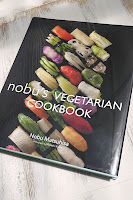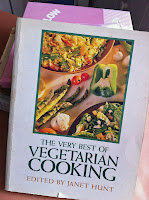From Miracle Juices,
Charmaine Yabsley and Amanda Cross, Hamlyn, 2001.
The name of this drink certainly didn’t inspire me to make
it; rather it turned me away. However when I read the ingredients
(melon, cucumber, avocado and dried apricots) it sounded interesting enough to
try.
Half a honeydew melon and one large cucumber were juiced. A
small avocado was added with 100g dried apricots soaked for 10 minutes. A
tablespoon wheat bran was added (though wheat germ was called for). This all
went into the blender to get a churn or two.
The mixture became very thick so I juiced some more of the
melon and added this. It was still too thick to drink and had to be spooned
instead.
The ‘drink’ was rich in vitamin E, zinc and iron so you
could almost feel it doing you good. It was flavoursome and not too sweet,
while the dried apricots added a little texture to the mixture.
This is another book dredged up from the unused section of
the bookshelf. It was obviously one of those titles bought in a rush of
enthusiasm and then not really used. Now that the effort has been made I shall
probably use it a little more often.
Taste: ✔✔✔
Ease of
cooking: ✔✔✔✔



















































